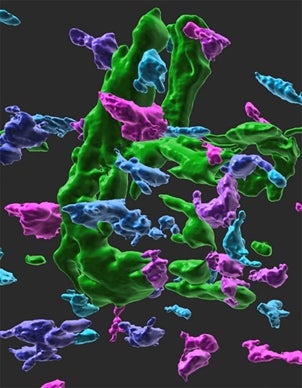A blood marker which predicts the risk of osteoporotic hip fractures in older men
September 12, 2022NUS scientists have discovered that blood levels of the chemokine protein CXCL9 reliably predict the risk of osteoporotic hip fractures in Chinese men.
Healthy bone requires a balanced activity of various bone cells, most importantly bone-forming osteoblasts and bone resorbing osteoclasts. This balance is achieved by continual communication between both cell types. Any communication failure results in bone diseases, such as osteoporosis, where uncontrolled osteoclast activity results in excessive bone resorption and bone fractures. Bone Mineral Density (BMD) is currently used to diagnose osteoporosis in clinical practice but a reliable marker to predict the risk of osteoporotic bone fractures is lacking. In a recent study published in the Journal of Bone and Mineral Research (JBMR), a team of researchers from the National University of Singapore (NUS) reported that the chemokine protein CXCL9 can be used as a blood marker to predict osteoporotic hip fractures in Chinese men.
Earlier work by a research team led by Associate Professor Christoph WINKLER from the Department of Biological Sciences, NUS had identified CXCL9 as factor that is produced by osteoblasts and controls formation and activation of osteoclasts (link). Blocking CXCL9 or its receptor CXCR3 prevented osteoporosis in experimental models but no study has validated a possible association between CXCL9 and osteoporosis or fracture risk in humans. The team followed up by collaborating with Professor KOH Woon Puay and her team at the School of Medicine, NUS to conduct a matched case–control study.
This study included 55 men and 119 women who had experienced a hip fracture with an average of 6.3 years after their blood was collected. The participants were matched individually to controls who did not develop hip fractures. Investigators observed higher blood levels of CXCL9 in the pre-fracture blood samples of men with subsequent hip fractures compared with their non-fracture controls. No such difference was seen for the women participants.
Prof Koh said, “The unexpected difference in the results between men and women in our study may be explained by how changes in sex hormone levels during ageing could influence the level and effects of CXCL9 differently in older men and women.”
“These findings open the possibility that future early interventions targeting CXCL9 or CXCL9-CXCR3 signalling could be beneficial in preventing hip fractures in older men,” added Prof Winkler.
| Visual shows immature osteoclast precursors (blue to magenta depending on maturation state) aggregate at osteoporotic bone lesion sites and mature into bone resorbing osteoclasts (green). Osteoclast recruitment and differentiation are controlled by the chemokine protein CXCL9 that is produced by osteoblasts. [Photo credit: Quang Tien PHAN] |  |
References
[1] Phan QT; Tan WH; Liu RR; Sundaram S; Buettner A; Kneitz S; Cheong B; Vyas H; Mathavan S; Schartl M; Winkler C*, “Cxcl9l and Cxcr3.2 regulate recruitment of osteoclast progenitors to bone matrix in a medaka osteoporosis model” PROCEEDINGS OF THE NATIONAL ACADEMY OF SCIENCES OF THE UNITED STATES OF AMERICA Volume: 117 Issue: 32 Page: 19276-19286 DOI: 10.1073/pnas.2006093117 Published: 2020.
[2] Phan QT; Chua KY; Jin AZ; Winkler C*; Koh WP*, “CXCL9 Predicts the Risk of Osteoporotic Hip Fracture in a Prospective Cohort of Chinese Men-A Matched Case-Control Study” JOURNAL OF BONE AND MINERAL RESEARCH DOI: 10.1002/jbmr.4646 Published: 2022.
Note: The research publication was selected to be featured in Wiley Research Headlines, a mailing that includes summaries of the most newsworthy research sourced from more than 1,600 journals worldwide published by Wiley (see: https://newsroom.wiley.com/press-releases/press-release-details/2022/Could-blood-marker-predict-the-risk-of-osteoporotic-hip-fracture-in-men/default.aspx).


